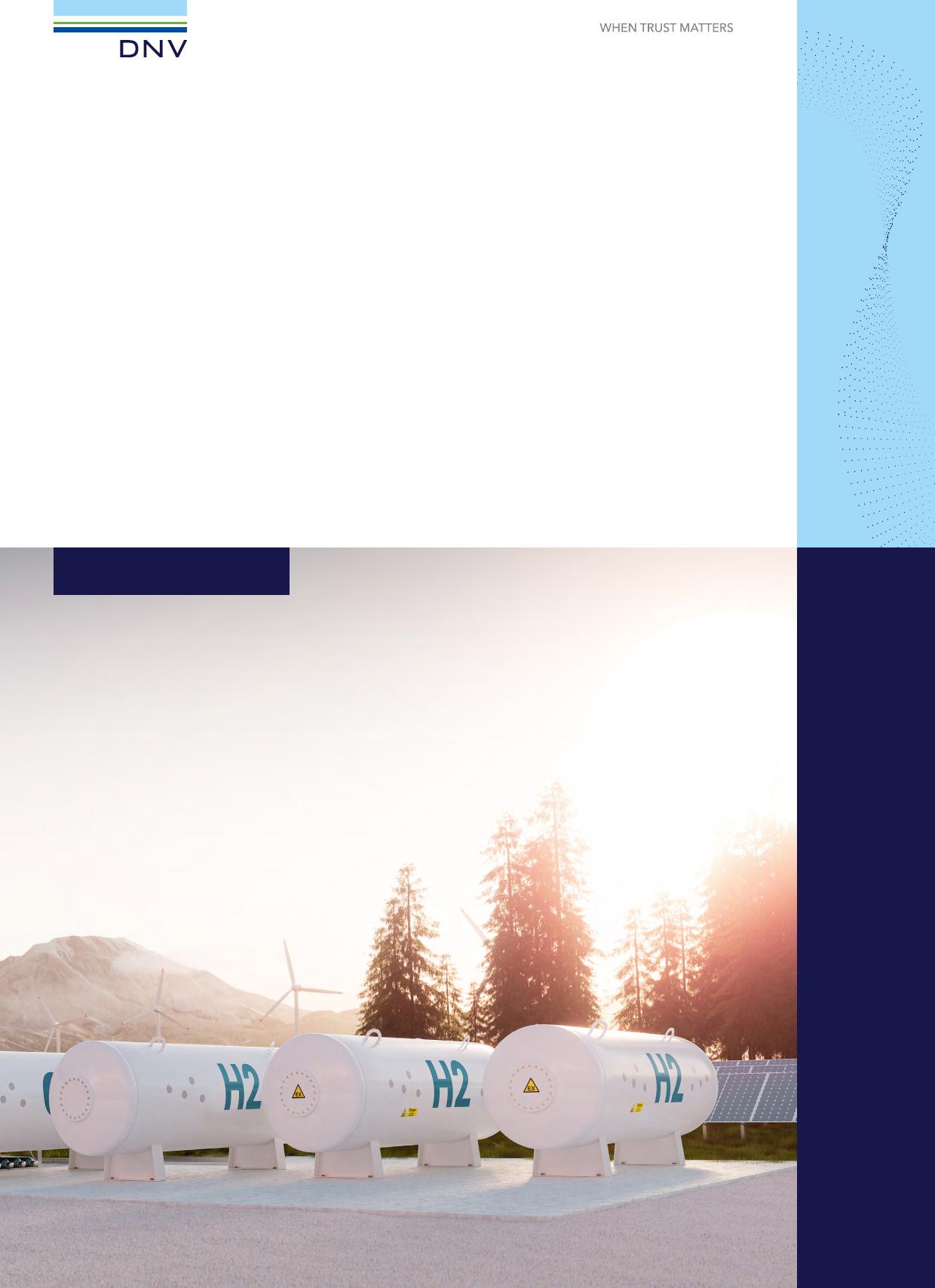REPORTRISINGTOTHECHALLENGEOFAHYDROGENECONOMYTheoutlookforemerginghydrogenvaluechains,fromproductiontoconsumption每日免费获取报告1、每日微信群内分享7+最新重磅报告;2、每日分享当日华尔街日报、金融时报;3、每周分享经济学人4、行研报告均为公开版,权利归原作者所有,起点财经仅分发做内部学习。扫一扫二维码关注公号回复:研究报告加入“起点财经”微信群。。Asrecentlyasthreeyearsago,cleanhydrogenenergywasonthefringesoftheenergy-transitionconversation–anoutliersolution,atleastfortheshortormediumterm.Today,itisrapidlymovingintothemainstreamand,formany,itisessentialtoanet-zeroenergyfuture.Inshort,theworldisheadingforhydrogen,buttherouteisuncertainandmanyquestionsremain.Howquicklycanhydrogensupplyscale-uptosupporthigh-demandindustries?Whatisnewabouthydrogenin2021?Whatarethemosturgentchallengesandtherequiredenablers?Whichareasofuncertaintycouldimpacthydrogenthemostinthenextfewyears?Thisreportexplorestheoutlookfortheemerginghydrogeneconomy,drawingonDNV’ssurveyofmorethan1,100seniorprofessionalsinvolvedintheemerginghydrogeneconomy,aswellasonin-depthinterviewswithseveralindustryleaders.Thereportexplorestheoutlookforthehydrogeneconomyinthreeareas:•Greatexpectations•Expectedchallengesandenablers•Challengingquestions.Wewouldliketothankthefollowingleadersforthetimeandinsightstheyprovidedtothisresearchthroughin-depthinterviews:•SebastianKoksAndreassen,CEOatGreenHydrogenSystems•AntonyGreen,projectdirector–hydrogen,NationalGrid•DrSanjayCKuttan,executivedirector,SingaporeMaritimeInstitute•TimPeeters,departmentmanager,ironandsteelR&D,TataSteelEurope;andMustaphaBsibsi,R&Dknowledgegroupleader,thermalprocesses,TataSteelEurope•RachelRuffle,CEONorthernEuropeatRES(RenewableEnergySystemsLtd)•KristinaWittmeyer,businessopportunitymanager–Hydrogen,ShellNorway•YuanZhengang,directorofNewEnergyResearchCenterofCPPEI(athinktankofCNPC)1,124Surveyrespondentsfromacrossthehydrogeneconomy80Countriesrepresented7In-depthinterviewswithindustryleaders27%RespondentsfromorganizationswithrevenuesinexcessofUS$1bnFormany,itisessentialtoanet-zerofutureTheworldisheadingforhydrogen2INTRODUCTIONRisingtothechallengeofahydrogeneconomyGreyhydrogen•Greyhydrogenistypicallyproducedfromnaturalgasinaprocesscalledsteammethanereformation•Brownhydrogenisproducedfromthegasificationofcoal(orlignite)•Thesearethestronglydominantmethodsinusetoday•Theyarerelativelycheap,butemitlargeamountsofCO2Bluehydrogen•Bluehydrogenisproducedfromfossilfuels(typicallynaturalgas),butemissionsaredealtwithusingcarboncaptureandstorage(CCS)technology•Withabundantnaturalgasandcoalavailable,bluehydrogencouldhelptoscalethehydrogeneconomy2•However,thisisdependentonwideradoptionofCCS•Bluehydrogencouldactasasteppingstonefromgrey/browntogreenhydrogenGreenhydrogen•Greenhydrogenisproducedbytheelectrolysisofwater•Theprocessispoweredbyzero-carbonelectricity(e.g.,windandsolarpower)•Itisclean,butiscurrentlytooexpensiveforwidespreaduse1•Thecostofelectrolysersandrenewableenergyisexpectedtofalloverthenextdecade,makinggreenhydrogenmoreviable•Greenhydrogenistheideallong-term,zero-carbonwaytoproducehydrogenHydrogenterminologyInthisreport,theterm‘hydrogen’referstolow-carbonhydrogen,unlessotherwisespecified.‘Low-carbonhydrogen’,inturn,referstoblueand/orgreenhydrogen.Thesearedefinedindividuallybelow.1.PathtoHydrogenCompetitiveness:ACostPerspective,HydrogenCouncil:https://bit.ly/3gZqLDw2.Unlockingthegreenhydrogenrevolution,Recharge:https://bit.ly/35UTAuzOilandgasindustryElectricityindustryServices/contractorTransportandheavyindustryGovernance,finance,strategyInthissurvey,amongrespondentsthatproduce,distribute,store,orconsumehydrogen,56%usegreenhydrogen,26%bluehydrogen,and20%greyorbrownhydrogen.Greyorbrownhydrogen(madefromgasorcoal,noCCS)BluehydrogenGreenhydrogenInvolvementintypesofhydrogen,bybroadindustrygroups32%35%52%13%20%67%19%27%61%21%28%52%14%22%47%3INTRODUCTIONRisingtothechallengeofahydrogeneconomyThehydrogenpledges,plans,andpilotsofrecentyearshavenowevolvedintoconcretecommitments,investmentsandfull-scaleprojects.1.0GreatexpectationsGREATEXPECTATIONSRisingtothechallengeofahydrogeneconomy4Short-termoutlookforthehydrogeneconomy,byregion�Theoutlookforahydrogeneconomyhasimprovedsignificantlyinthepast12months�Theoutlookforahydrogeneconomywillimprovesignificantlyinthenext12monthsAllrespondentsAsiaPacificEuropeLatinAmericaMiddleEastandNorthAfricaNorthAmerica74%57%78%64%87%78%67%57%70%52%77%72%In2021,hydrogenholdsthestatusofaviableandrapidlydevelopingpillaroftheenergytransition.Three-quarters(74%)ofenergyprofessionalssaythattheoutlookforahydrogeneconomyhasimprovedsignificantlyinthepast12months,whiletwo-thirds(67%)expectthistocontinueinthenext12months.Today,just8%ofhydrogenrevenueearnersinoursurvey(i.e.,thoseinvolvedinhydrogenproduction,distribution,technology,engineering,infrastructure/facilitydevelopmentorfinancing/investinginhydrogenprojects)derivemorethanone-tenthoftheirtotalrevenuefromtheirhydrogenoperations.By2025,thisisexpectedtorisefivefold,to44%.By2030,thisnumberwillriseto73%.Attheotherendofthisnewenergyvaluechain,thegrowthofspendingonhydrogenconsumptionforenergyand/orfeedstockisexpectedtogrowatonlyaslightlyslowerrate.By2025,33%ofhydrogenconsumersexpecthydrogentorepresentmorethanone-tenthoftheirorganizations’energy(and/orfeedstock)spending,upfromjust9%today.Thisisprojectedtoriseto57%by2030.Takentogether,thesenumbersareimpressiveconsideringhownewhydrogenistomostorganizations.Astrongmajorityofthosewesurveyed(71%)haveonlybeguntheirinvolvementwithhydrogenwithinthepastfiveyears,while55%haveonlycommencedwithinthepastthreeyears.5GREATEXPECTATIONSRisingtothechallengeofahydrogeneconomyFromsmallbasetomajorroleFormanyinoursurvey(45%),hydrogenaccountsforlessthan1%oftheirorganization’srevenue.Indeed,mostorganizationswithhydrogeninterestsarenotpureplays–rather,hydrogenisanew,butincreasinglyimportant,venturewithinanestablishedbusiness.“Greenhydrogen,forme,isthefinalpieceofthejigsaw.”RachelRuffle,CEONorthernEuropeatRES“Wealwaystalkaboutthetrilemmaofenergysecurity,sustainability,andcost,andthetrade-offsthathavehistoricallybeenneededbetweenthem,saysRachelRuffle,CEONorthernEuropeatRES,aglobalrenewable-energybusiness.“Wehaveessentiallyresolvedthesustainability-costequationbecauserenewableenergyisnowthecheapestformofnewelectricitygeneration.Butthevariabilityofrenewableshasnotbeenresolved.Thatiswhatsparkedourinitialinterestinhydrogen.Itcouldsupportlong-termenergystorage,helpingtomakeuseofsurplussupply,andalsomeetpeakdemand.”ButasRachelRuffleadds,overthepastfewyears,hydrogen’sroleinthefutureofenergyhasgrownmuchmorefundamental.“Itisnownotjustaboutdecarbonizingtheelectricitysector,”shesays,“butthewholeoftheenergysector,includinginheavyindustrywheregreyhydrogenisbeingused.”DNV’sEnergyTransitionOutlook(ETO)findsthatonlyaround20%offinalenergydemandtodayisforelectricity.Electricityasashareofoverallenergydemandissettodoubletoaround40%by2050,butthisleavessignificantdemandinourforecastforfossilfuels,whichwillneedtobereplacedbygreaterelectrificationorbydecarbonized/greengasessuchashydrogen,iftheworldistomeetthetargetsoftheParisAgreement.Expectationsforhydrogentoaccountfor10%and50%ofrevenue/spending,by2025and2030202120252030��Percentageofrespondentswhoexpecthydrogentoaccountformorethan10%oftheircompany’srevenue/spending�Percentageofrespondentswhoexpecthydrogentoaccountformorethan50%oftheircompany’srevenue/spendingFiguresareanaveragecombiningresponsesfromhydrogenrevenuegeneratorsandconsumers8%2%39%9%64%26%3.EnergyTransitionOutlook2020,DNV:https://eto.dnv.com/20206GREATEXPECTATIONSRisingtothechallengeofahydrogeneconomy4.Worldironoreoutputtorise5.1%by2025—report,Mining.com:https://bit.ly/3h0tmgrHydrogenconsumersexpectarapidincreaseintheirusageOurresearchshowsthathydrogenproducersareinvestingandupscalingtogeneratevastamountsofgreenandbluehydrogeninthecomingyears.Theyareconfidentenoughtodosobecauseseveralindustriesaresimultaneouslybuildingthedemand-sideofthehydrogeneconomy.Theseindustriesneedtoreinventmanyoftheirplants,machines,models,andpracticestoswitchtohydrogen.Mosthaveapressingneedtoreplaceacarbon-intensivepartoftheirbusiness–thetopdriverofhydrogenadoptionamongconsumer-businessesinoursurvey.Hydrogencanbeasubstituteforeitherfossil-fuel-basedenergyorfeedstockneedsintheseindustries.Forexample,long-haultruckingfleetscanreplacedieselwithhydrogenfuelcells;powercompaniescanexchangenaturalgasturbinesforhydrogen-burningalternatives;andchemicalcompaniesthatproduceammoniacanswapgrey/brownhydrogenfeedstockforblue/greenequivalents.Thesteelindustryisonethatcouldultimatelycreateenormousdemandforhydrogen.Globally,oversixmilliontonnesofironoreisminedeveryday,addinguptoovertwobilliontonnesayear.Thisgiantindustryisstillgrowing,withironoreproductionforecasttoriseby5.1%between2021and20254.Targetinghigh-impactapplicationsAlmostalloftheworld’sironoreisconvertedintopigiron–theprimaryingredientinalltypesofsteel.Thisprocessisthemostcarbonintensivepartoftheindustry,andalsoanareawherehydrogencouldhelpthemost.Thisisbecauseitishasthepotentialtoserveasbothaprimaryfeedstock(replacingcarbon,intheformofcoke,asareducingagentintheprocessthatfreesironfromironoxide)andasanenergysource(replacingfossilfuelsinvariousheat-intensivestagesoftheiron-andsteelmakingprocess).Evolvingthesteelmakingindustrytowardsnetzerotargetsisthebiggestchallenge–andthebiggesttransformation–thesectorhasfacedoverthecourseofovertwocenturies.Manytechnicalbarriersexist,manyofwhicharenotwell-understoodoutsidetheindustry.“Theoutsideworldexpectstheindustrytochangeveryquickly,”saysTimPeeters,departmentmanager,ironandsteelR&D,TataSteelEurope,partofamajormultinationalsteelmakingbusiness,“butthekindofplantweneedtobuildonlyexistsonpaper.Ithasneverbeendoneinpractice,atfullscale.Peopleoverlookthetechnicalchallengesthatarestillaheadofus,andsoweneedtocommunicatethetransitionpathweareonandthestepsthatneedtobetaken.”However,evenifthesetechnicalchallengesweresolved,itwilltakeseveralyearsbeforethereisenoughgreenorbluehydrogentoservethesteelmakingindustry.“Goingfullhydrogenmeansyouneedahugeamountofhydrogen.JustforourbusinessintheNetherlands,wewouldneedapproximately1.5milliontonnesofhydrogenannuallytotransformcompletelyfromcoaltohydrogen.Thatisamajorbottleneckwhenyouconsiderhowsmallgreenhydrogenproductionisatthemoment,”saysMustaphaBsibsi,R&Dknowledgegroupleader,thermalprocessesatTataSteelEurope.Onlyincludeshydrogenasenergycarrier.Maritimesyntheticfuelsarecountedashydrogen.DNVEnergyTransitionOutlook2020��RoadMartimeBuildingsManufacturingBasematerialsIronandsteelManufacturedgoodsUnits:EJ/yr7GREATEXPECTATIONSRisingtothechallengeofahydrogeneconomyAligningroadmapsLikemanyprospectivehydrogen-consumingindustries,thesteelindustryneedsaclearroadmapfromthesupply-side,showingtheavailabilityofspecificamountsofhydrogenoverthecomingyears.“Ifyoureallyneedtoreplace,forexample,asingleblastfurnacewithahydrogen-basedironmakingtechnology,thatinitselfisahugestep,”saysPeeters,“It’snotagradualchangefromonetotheother.Sobywhendoweneedthattobeready?Bywhenwillthehydrogenbeavailable?”Thesupply-side,ofcourse,needsasimilarroadmapfromtheindustrialusers,sothattheycanbuildproductiontomatchdemand.“Onbothsides,andwithregulators,policymakers,andallotherstakeholders,thereisaneedtocoordinateandcollaborate,”saysBsibsi.HydrogenmakesbusinesssenseOfcourse,companieswouldnothavesuchhighgrowthexpectationsifhydrogendidnotmakebusinesssense.Infact,amongsurveyrespondents,thebeliefthatitrepresentsaprofitablebusinessopportunityisthebiggestdriverforthoseinvolvedinthehydrogeneconomy,especiallyforinvestors,producersanddistributors.However,amongthekeydriversinourresearch,profitabilityiscloselyfollowedbysustainabilityfactors.Theneedtoreplaceacarbon-intensivepartofthebusiness,andanethicalconvictionontheneedtocontributetoanet-zeroenergysystem,tieforsecondplaceinourlistofhydrogendrivers.Indeed,mostrespondentsbelievethathydrogeniscriticaltothefightagainstclimatechange:•84%believethathydrogenhasthepotentialtobeamajorcomponentofaglobal,low-carbonenergysystem.•73%sayParisAgreementtargetswillnotbeachievablewithoutalarge-scalehydrogeneconomy.•74%saythat,whethereconomicallyviableornot,thereisnowaytoachieveazero-carboneconomyby2050withouthydrogen.Inthiscontext,howtheenvironmentaleffectsofhydrogenprojectsaremeasurediscrucialtoassessingitsrealimpact.“Thatanalysisisimportantbecause,inthepast,therehasbeenatendencytousethenarrowestofboundariestojustifywhywedoonethingoranother,andIthinkthatispartofwhywehavedevelopedanunsustainableworld”,saysDrSanjayCKuttan,executivedirectoroftheSingaporeMaritimeInstitute.Hydrogenhashadafewfalsedawnsinthepast,buttherehasneverbeenanythinglikethecurrentlevelsofinvestment,governmentsupport,andindustrycommitment.Allofthesewillbecrucialtomeetingthegreatexpectationsrespondentshaveforhydrogen–bothforboostingnetprofitandmovingtowardsnetzero.Topdriversofinvolvementinthehydrogeneconomy54%18%23%23%33%36%38%46%46%Profitablebusinessopportunity�Ethicalconvictionontheneedtocontributetoanet-zeroenergysystem�Theneedtoreplaceacarbon-intensivepartofthebusiness�Opportunitiestostorerenewableenergy�Creatingnewusesforexistinginfrastructure�Regulatory/governmentpressuretodecarbonize�Pressurefromshareholders/investorstodecarbonize�Governmentsubsidiesorotherincentives�Societalpressureandpublicperceptionofourbrand�Opportunitytomaintainamarketforfossilfuels“Weneedtotakeafulllife-cycleperspectiveasweadopthydrogen,consideringthetotalcarbonfootprint,coveringallfactorsandnotjustthinkingabouthydrogenatthepointofuse.”DrSanjayCKuttan,executivedirectoroftheSingaporeMaritimeInstitute.21%8GREATEXPECTATIONSRisingtothechallengeofahydrogeneconomyHydrogen:similaryetdifferentHydrogenisafascinatingprospectbecauseofitsuniquefeatures.Technically,itisnotafuel,eventhoughitcanbeusedasone.Aswithelectricity,hydrogenisanenergycarrier–and,likeelectricpower,itcanbeusedto‘charge’batteries(comprisedoffuelcells).Butitisalsoexplosive.Itproducesheatwhencombusted.Itcanbeheldintanks,movedthroughpipelines,andstoredindefinitely.Intheserespects,itismuchmorelikefossilfuels.Hydrogenisatoncefamiliaranddifferentfromanythingelseintheenergysystem.And,whilemuchoftherequiredhydrogentechnologyisproven,hydrogenvaluechainsrequirealotofdevelopment.“Alotoftoday’shydrogentechnologyisnotnew–ithasbeenaroundfordecades,”saysKristinaWittmeyer,businessopportunitymanager–hydrogen,atShellNorway.“However,toscalethesetechnologiestomeetthedemandandnewapplicationsthatareexpectedwillrequirenewideas,processes,andmodels.”“Thechallengetodayishowwecanputalltherequiredelementstogetherinawaythatisviable,reliable,andlarge-scale–that’swheretheinnovationis.”KristinaWittmeyer,businessopportunitymanager–hydrogen,atShellNorway9GREATEXPECTATIONSRisingtothechallengeofahydrogeneconomyRespondentsarenotblindtothesignificantchallengesinvolvedinkeepingthehydrogeneconomyonarapid-adoptiontrajectory.2.0ExpectedchallengesandenablersEXPECTEDCHALLENGESANDENABLERSRisingtothechallengeofahydrogeneconomy10Some71%ofrespondentsbelievecurrenthydrogenambitionsunderestimatethepracticallimitationsandbarrierstoadoption.Infrastructureandcostaretwoofthebiggesthurdles,whiletherightregulationsaredeemedthemostpowerfulenabler,followedbycarbonpricing.Provingthesafetycasewillalsobekeytoscalingthehydrogeneconomy.InfrastructureandinvestmenttomatchambitionGovernmentsandindustryaretargetingfull-scaleadoptionofhydrogeninmanyregionsandinseveraldomains,rangingfromenergystoragetoconsumptionintransport,buildings,andindustry.Thisrequirestherolloutofadiverserangeofsupportinginfrastructure,sothathydrogencanbeproduced,moved,stored,distributed,andintegratedintothewiderenergysystem.Hydrogeninfrastructuremustbebuiltatlarge-enoughscale,low-enoughcost,andfast-enoughspeedtoensurethehydrogeneconomycanplayakeyroleintheenergytransition.Withoutsufficientprogressoninfrastructure,hydrogeneconomyparticipantswillfacesignificantbarriers;basedonourresearch,thisisamajorconcern.Respondentsselectedalackofinvestmentinhydrogeninfrastructure(38%)asthejoint-highestrisktheirorganizationsfaceinrelationtohydrogen.Forthosecurrentlynotinvestedorinvolvedinhydrogen,alackofinfrastructureisthetopreasonwhytheyfocusedelsewhere.Therearelessonsthehydrogenindustrycandrawfromthematurationandintegrationofrenewableenergysourcesoverthepasttenyears,particularlywindandsolarpower.However,therearemajordifferences,too.“Whatwindturbineshavedoneisproduceelectricityinadifferentway,buttheworldalreadyrunsonelectricity,”saysSebastianKoksAndreassen,CEOatGreenHydrogenSystems,amanufacturerofelectrolysersforhydrogenproductionfromrenewableelectricity.“Greenhydrogenisdifferent,becausewenotonlyneedtofindawaytoproduceitonanindustrialscale,butwealsoneedtodeveloptotallynewinfrastructureinmanycases,andthataddsanadditionaldimension.”Natural-gasdistributionnetworksare,potentially,apartialexception.Althoughtheyrequiresignificantinvestmenttoberepurposedforhydrogen,thereisgrowingconfidencethatthiscanbedonesuccessfully.DNVisanalysingpotentialopportunitiesforreusinggasnetworksinseveralcountries,andtheseprojectsareshowingthatreuseofferssubstantialcostsavingsoveralternatives.TheGasforClimateconsortiumhasmadesimilarconclusionsinitsEuropeanHydrogenBackboneresearch.5Around78%ofrespondentsinoursurveybelievethatre-purposingexistinggasinfrastructurewillbekeytodevelopingalarge-scalehydrogeneconomy.“Ourresearchworkisshowingthatthemajorityofourassetsareindeedcapable,”saysAntonyGreen,projectdirector–hydrogen,atNationalGrid,aBritishelectricityandgasutility.“Ithasshownusthattherearereallynoshowstopperstore-purposingournaturalgasnetworkforhydrogentransmission.”5.TheEuropeanHydrogenBackbonevision,GasforClimate:APathto2050:https://gasforclimate2050.eu/Greatestrisksinprogressingthehydrogeneconomy11%14%20%21%29%29%38%38%38%�Highcostofgreenandbluehydrogen�Regulatorychangesorlackofrequiredlegislativeframeworks�Lackofinvestmentinhydrogeninfrastructure�Lackofinvestmentinhydrogentechnology/innovation�Shiftinpolicy/governmentalsupport�Safetyissues�Advancesinbatterytechnology�Skillsshortages�Failuretoscalecleanhydrogen11EXPECTEDCHALLENGESANDENABLERSRisingtothechallengeofahydrogeneconomySafesystemsforhydrogenSafetywillbekeytoscalingthehydrogeneconomy.Itistheseventh-highestriskforourrespondentsinalistoffactorsthatcoulddisruptprogressinthehydrogeneconomy.Inturn,globallyacceptedhydrogenstandardsandrecommendedpractices–akeyaspectofsafetymanagement–arethesixth-placedenablerofasuccessfulhydrogeneconomy.“Safetyhastobefrontandcentreofthehydrogenagenda.Weneedtodemonstratethatwhatweplantodoissafe,andwillremainsafegoingforwards,”saysAntonyGreen.“Amajorareaforusistoproveournetworkcancarryhydrogensafely,withoutanyadditionalrisk.So,weareconstructingaGBP12.7mprojectatDNV’sSpadeadamtestsite.Itwillcompleteabeach-to-meterfacilityononesite,whichwillhelpusprovethatthepipework,valves,andsafetydevicesallfunctionproperlyinahydrogenworld.”AntonyGreen,ProjectDirector–Hydrogen,atNationalGrid6.‘Industrycollaborationsupportstheintegrationofrenewableelectricitybyenablinghydrogenadditiontonaturalgas’,DNV:https://bit.ly/2WfGVgv7.‘Provingthesafetycaseforhydrogen’:DNVinGastechInsights:https://bit.ly/2Wf5E4j8.‘DNVdeliversaminimumpuritystandardforthefutureuseofhydrogeninUKhomesandbusinesses’,DNV:https://bit.ly/3d1YeIw9.HeatingDutchhomeswithhydrogen’,DNV:https://bit.ly/2WfH1onForhydrogentogainbroadacceptanceandadoption–indomesticsettingsandfornewapplicationsbeyondcurrentindustrialuses–industryandregulatorswillneedtoestablishrobustsafetystandardsforeachspecificusecase,justastheydoforotherpotentiallydangeroussubstances.Workisalreadywellunderway,perhapsexplainingwhysafetyisontheradarofrespondentsbutnotamongthetoprisksandenablers.Forexample,gas-networkoperatorsarecollaboratingtocreateguidelinesfortheintroductionofhydrogenintonatural-gasnetworks.6Workisalsounderwaytoestablishsafetystandardsforhydrogenwithinhomes,7determineminimumpuritylevels,8andexploresmall-scale,inner-citygreenhydrogenproduction.9Thisrepresentsimpressiveprogresstowardswideradoptionofhydrogen,butmoreisneededtoassuregovernmentsandsocietyatlargethatitisasafeandviableenergysolution.HyStreetinfrastructureatDNV’sSpadeadamResearchandTestingfacility,playingavitalroleinprovingthesafetycaseforhydrogen.12EXPECTEDCHALLENGESANDENABLERSRisingtothechallengeofahydrogeneconomyDown-scalingcostsWhileinfrastructureneedstoscaleup,thecostofgreenandbluehydrogenneedstocomedown.Currently,low-carbonhydrogenisexpensiveandfailuretofindawaytoreducecostisanotherofthetoprisksidentifiedbyourrespondents.“Theindustrymustdevelopinordertoreducethecostoftheentirechain,fromproductiontodistributionandconsumption,italldependsoncommercializationtodecreasecosts.”YuanZhengang,directorofNewEnergyResearchCenterofCPPEI(athinktankofCNPC)“Intheearlystageswhenthecostsarehigh,enterpriseshavetofollowlong-termstrategiesandimplementplansthatmaylackprofits.Buttheywillgainmarketshareintheindustry,andoncehydrogensupplyanddemandincrease,costswillbereduced,andprofitswillimprove,”saysYuanZhengang,directorofNewEnergyResearchCenterofCPPEI(athinktankofCNPC),China’sstate-ownedoilandgascorporation.Forcoststocomedownsmoothly,hydrogensupplyanddemandneedtodancetothesamerhythm,expandingatsimilarrates,withoutoneleading,orlagging,thestepsoftheother.“Thereisanelementofdemandandsupplymechanismsneedingtoprogressanddevelopinparallel,”saysSebastianKoksAndreassen.“Inmostmarkets,apartfromregulationandpolicies,thisisreallyaboutmaturingthedemandside,whereasignificantamountofinfrastructureinvestmentisrequiredtoallowthesocietytostartrunningongreenhydrogen.”Onthesupplyside,Andreassenpointsoutthatelectricityfromrenewablestakesuparoundtwo-thirdsofthetotalcostofgreenhydrogen.“Thegreenhydrogenindustrywillneednotonlyenoughgreenelectricity,butalsoelectricityatlowercost,andwebelievethatispossiblebasedonforecastsandouranalysis.”SebastianKoksAndreassen,CEOatGreenHydrogenSystemsEconomicsbyapplicationHydrogenisclosertomakingeconomicsenseinsomeapplicationsthanothers.Forinstance,settingasidetheinfrastructure,safety,andpracticalbarriers,itwillbealongtimeuntiltheworldhasthecapacitytoproduceenoughgreenhydrogentopowerinternationalshippingfleets.“Toproduceenoughgreenhydrogenforthemaritimeindustrywithcurrentmethodswouldrequireseveraltimesthetotaloutputfromallrenewableandnuclearenergygeneratedtoday,”saysSanjayKuttan.“Andthatisontopofallthegrey/brownhydrogenthatneedstobealsoreplacedinapplicationssuchasenergy,agricultureandindustry,coupledwiththefactthattherenewableelectricitycannotbedeployedelsewhereacrosstheeconomy.Sowithoutmajortechnicalbreakthroughs,Icannotseehowhydrogenisgoingtobecometheprimaryfuelfortheinternationalmaritimesectoranytimesoon.”Itisthereforeimportantthathydrogenisusedinapplicationswhereitisbest-suited,whereithasthemostpotential,andwhereitmakesbusinesssense.But,inadditiontotheeconomicsofindividualapplicationsandthedynamicsofagrowingmarket,costscanalsobedrivenbytechnologyinnovationsandstandardization.“Forexample,oneofthebiggestvariablesfromacostperspectiveishydrogencompression,”saysAntonyGreen.“Thecompressorswehavecurrentlyareexpensive,soweneedtolookatwhatcanbedonetoreducethatovertimeandtakeopportunitiestostandardize.Thisisoneareawherenetworkscancontributetoloweringcostsoverall.”RegulationstipthescaleRegulatorychanges,oralackofrequiredlegislativeframeworks,arethethirdofthejoint-toprisksorganizationsfaceintheirprogressthroughthehydrogeneconomy.Butregulationscantipthescaleinbothdirections,alsocominginasthetopchoicewhenweaskedrespondentswhichfactorwould,betweennowand2030,bethemostimportantenablerofasuccessfulhydrogeneconomy.Whatthehydrogeneconomyneedsisstrong,stable,andsupportiveregulations.Currently,regulatoryregimescouldholdbackthedevelopmentofhydrogen–notonlyregulationsthatgovernhydrogendirectly,butalsotheindustrieswherehydrogencouldbeused,ortheindustriesthatsupporthydrogenproduction.Akeyexampleistheregulatoryframeworkforrenewableelectricity,whichcanimpacttheviabilityofgreenhydrogenproduction.“Wewouldliketoseemoregovernmentsevolvetheirpermittingregimesaroundwind,solar,andelectricity,”saysRachelRuffle.“WearenotdoingmuchinEnglandbecauseoflimitingplanningpolicywhereas,inScotland,Ireland,andWales,heightlimitspreventusfrombuildingthemostpowerfulandefficientsystems.So,forexample,wearecurrentlybuilding2MWwindturbinesinScotland,but6.4MWturbinesinGermanyandScandinavia.”13EXPECTEDCHALLENGESANDENABLERSRisingtothechallengeofahydrogeneconomyPoliciestodrivethehydrogeneconomyforwardRegulationsoftenflowdirectlyfromgovernmentplansandpolicies.Manycountries–includingAustralia,Canada,Chile,Finland,France,Germany,Japan,Netherlands,Norway,Portugal,theUSandSouthKorea,aswellastheEuropeanUnion(EU)–haveplanstogrowhydrogenproductionand/orconsumption.10“Itreallyhelpstohaveclearpolicyframeworksthataretransparentonlong-termgoals,”saysKristinaWittmeyer.“Thetargetsthatareset,forexample,bytheEU,providegreaterpredictability,whichhelpsincommercialdecisionsthatdriveinvestmentsinhydrogen.”Chinalookslikelytomakeamajorpushtowardshydrogenadoptioninthenearfuture,andthiscouldsignificantlyacceleratethehydrogeneconomy,giventhesizeofChina’smarkets,industries,andenergyneeds.10.CountriesRollOutGreenHydrogenStrategies,ElectrolyzerTargets,PowerMagazine:https://bit.ly/3hbsLHM&USDepartmentofEnergyreleasesHydrogenProgramPlan,electrive.com:https://bit.ly/3h24h4Y11.Chinapusheshydrogenenergytoachievecarbongoals,NikkeiAsia:https://s.nikkei.com/3A4ycRi“Inthenextone-to-twoyears,theintroductionofhydrogen-relatedpolicieswillsignaltherealcommencementofhydrogenmorebroadlyinChina.”YuanZhengang,directorofNewEnergyResearchCenterofCPPEI(athinktankofCNPC)“Thiscouldinclude,forexample,atop-levelstrategyatnationallevel,plusindustrialdevelopmentplanning,medium-tolong-termplanning,anddesignatinghydrogenasastrategicenergy,”saysYuanZhengangofCNPC.“In2020,theChinesegovernmentenactednewpoliciestoincentivizehydrogenfuelcellvehicleadoptioninseveralcities.Thetargetsforthesecitiesincludeloweringthecostofhydrogen,improvingtechnologies,andincreasingthenetworkofhydrogenrefuelingstations.Intermsofthepublictransportationsectororcommercialvehiclemarket,Chinahasincomparableadvantagesindrivingtheindustryforwardduetoitslarge-scalepopulationandurbanagglomerationnetwork,whencomparedtomanyothercountries,”saysYuanZhengang.80%Saythehydrogeneconomyneedseffectivecarbon-pricingregulationsbeforeitcanscale-up14%16%18%20%21%28%37%38%42%47%Mostimportantenablersofahydrogeneconomyto2030�Regulations�Carbonpricing�Largerandlower-costelectrolyzers�Nationalhydrogenstrategies�Government-fundedinfrastructure�Larger-scale,lower-costCCS�Privatesectorinnovation�Freemarketforces�Environmental,socialandgovernancefocusedinvestment�Globallyacceptedhydrogenstandardsandrecommendedpractices14EXPECTEDCHALLENGESANDENABLERSRisingtothechallengeofahydrogeneconomyLackofhydrogeninfrastructure�Lackoftechnicalexpertiserelatedtohydrogen�Lackofopportunitiestoenterthehydrogenmarket�Betterprospectsinotherenergyindustryinvestments�Hydrogenisnotaneffectiveorefficientwaytodecarbonizeenergy�Lackofgovernmentsubsidies/supportforhydrogen�InsufficientdemandforhydrogenInsufficientsupplyofhydrogen�Assetprices(andvaluationsforhydrogencompanies)aretoohigh�Financialrisksaretoohigh�Notaviable/profitablebusinessstrategyWhynothydrogen?OfthosewhotookDNV’ssurveywhoarenotinvolvedinhydrogen,1in5saysitisnotaneffectiveorefficientwaytodecarbonizeenergy,while18%ofthosenotpursuinghydrogensaythatthereasonisthathydrogenisnotaviable/profitablebusinessstrategyforthem.However,thetopreasongivenfornotpursuinghydrogenisthelackofhydrogeninfrastructure,followedbyalackoftechnicalexpertise.Topreasonswhysomeorganizationsarenotinvestinginorgettinginvolvedinhydrogen12%12%14%16%16%18%20%21%23%29%33%15EXPECTEDCHALLENGESANDENABLERSRisingtothechallengeofahydrogeneconomyEnergytransitionstakedecades,andtherearestillmanyopenquestions,uncertainties,andunresolveddebatesaboutthefuturehydrogeneconomy.3.0ChallengingquestionsCHALLENGINGQUESTIONSRisingtothechallengeofahydrogeneconomy16Manyofthesequestionsarecriticallyimportant,butotherscanbecounterproductive.Forexample,indecarbonizingtransportandindustry,mostprojectionsconcludethatthiswillrequirebothhydrogenandgreaterelectrification,dependingontheapplication,location,andnumerousindustry-specificconsiderations.12“Youhavepeopleattheoppositeextremesarguingforelectrifyingeverythingorusinghydrogenforeverything,”saysAntonyGreen.“Actually,bothhavearoleandsupportoneanotherinawholesystemsapproach.Weneedtostopwastingeffortarguingaboutextremesandfocusonthemiddleground.Ultimately,themarketwilldecidewhereelectrificationisbestandwherehydrogenisbest,butbothareimportantifwearetohitour2050targets.”Ourrespondentsagree,with80%sayingthathydrogenandelectrificationwillworkinsynergy,helpingbothtoscaleup;just16%believehydrogenandelectrificationwillbeincompetitionforthesameshareoftheenergymix.TheroleofbluehydrogenThedebateovertherelativemeritsofgreenandbluehydrogenissimilarlyunproductiveattimes,butitisnotasclearcut.Whilegreenhydrogenproductioniscommonlyregardedastheultimateaim,DNV’sEnergyTransitionOutlookforecaststhatbluehydrogenwillbekeytoscalingthehydrogeneconomy,with85%ofhydrogenusedasanenergycarrierin2030beingblue.Greenhydrogenproductionwillrampupfrom2035andgrowatafasterpacethanbluehydrogeninthe2040s.Thecostofelectrolysersandrenewableenergyisexpectedtofalloverthenextdecade,makinggreenhydrogenmoreviable.Incontrast,bluehydrogenhaslowerproductioncostsandmayhaveanequallylowcarbonfootprintasgreenhydrogen,whenlifecycleemissionsofsolarpanels,windfarms,andnatural-gasproductionareconsidered.Weforecastaroughly50/50splitbetweenblueandgreenhydrogenin2050.Themajorityofourrespondents(77%)believethatbothblueandgreenhydrogenneedtoworkinsynergytoscalethehydrogeneconomysuccessfully,buthowthemarketwillbedividedisuncertain.By2030,justunderhalfbelievethatmorebluehydrogenwillbeproducedandconsumedthangreenhydrogen,while35%havetheoppositeview.Thenumbersarecloserintheelectricityindustry,leaningmarginallytowardsgreen(42%to40%).Intheoilandgasindustry–theprimarydeveloperofbluehydrogen–morerespondentsexpectblue(53%)tohavethegreatermarketsharein2030thangreen(29%).Thisisdespitethefactthatfarmoreofourrespondentsareinvolvedingreenhydrogen(56%)thanblue(26%).Thereasonforthisisthatbluehydrogen,oncemature,willlikelyseehighervolumesofproductionperorganization(orperproject)thangreenhydrogen.12.NetZeroby2050:ARoadmapfortheGlobalEnergySector,IEA:https://www.iea.org/reports/net-zero-by-2050Theviewonhydrogenandelectrification,by2030Theviewongreenandbluehydrogen,by2030�16%�Hydrogenandelectrificationwillbeincompetitionforthesameshareoftheenergymix�80%Hydrogenandelectrificationwillworkinsynergy(notincompetition),helpingbothtoscaleup�35%�In2030,moregreenhydrogenwillbeproducedandconsumedthanbluehydrogen�47%In2030,morebluehydrogenwillbeproducedandconsumedthangreenhydrogenThebalanceofrespondentsselected“Don’tknow”or“Notapplicable”.Thebalanceofrespondentsselected“Don’tknow”or“Notapplicable”.17CHALLENGINGQUESTIONSRisingtothechallengeofahydrogeneconomyWillhydrogenglobalize?Respondentstooursurveyaredividedonwhetherhydrogentradewillbecomeafullyglobalizedmarket(42%),likeliquefiednaturalgas(LNG)forexample,orwhetheritwillbemoreofapatchworkofregionalmarketswithoutsignificantimport/exporttradeandintercontinentaltransport(52%).Bluehydrogenwilllikelybecreatedatornearexistingoilandgasrefineries,whichareoftenlocatedclosetootherindustrialsectorsthatmaybecomebluehydrogenconsumers.Theyarealsooftenlocatednearports,andsolong-distancetradecouldbeanaturalmove.Greenhydrogencanbeproducedatornearshippinghubs,particularlywhenpoweredbyoffshorewind.However,renewableelectricitycanalsobetransmittedtolocationsofhydrogendemand,whereelectrolyserscouldthenproducehydrogenclosetowhereitisneeded.“Atsomepoint,theelectricitysourceandtheelectrolysisthatmakesgreenhydrogen,needtobecoupled,”saysSebastianKoksAndreassen,“andthatdoescreateageographicalaspect.Hydrogencanbecomeaglobalmarketwithlong-distancetrade,butclearlytransportcostsarealwaysafactor,andsooftentherewillbegoodreasontoproduceandusehydrogenclosertothesourceofrenewableelectricity.”Theneedforlong-distancegreenhydrogentradeisdrivenbycaseswherelargequantitiesofrenewableelectricitycanbegeneratedinplacesthatarefarfromareasofhighdemand,and,conversely,areasofhighdemandthatdonothaveaccesstosufficientrenewableelectricitytoproducegreenhydrogenlocally.AustraliaandJapanhavetheserespectiveattributes,afactthathasdriventhedevelopmentofalarge-scalehydrogentradepilotprojectbetweenthetwonations.13Willhydrogenbepricedlikeoilandgas?Asmentionedabove,hydrogenhasauniquemixofattributesthatgiveitsimilaritiestoelectricityandtoafossilfuel.Electricitypricesareoftengovernedbyregulatorybodies,whichservetoprotectconsumersandguaranteeastablerateofreturnforproviders.Manyfossil-fuelpricesaredrivenbyfree-marketforces,whichmakesthemmorevolatile.So,howwillhydrogenbepricedoncethemarketmatures?Overall,oursurveyrespondentsareneatlydivided,with41%anticipatingitwillbedrivenbymarketforces,and43%expectingaregulatedrateofreturn.Insomegroups,thereareclearerexpectations.Forexample,greaternumbersofelectricity-industryrespondentsexpectregulatedprices(50%),ratherthanmarket-drivenprices(40%).TheoppositeistrueamongNorthAmericanrespondents,wheremoreexpectmarket-drivenprices(57%)thanregulatedprices(33%),inkeepingwiththeregion’sgeneralleaningtowardsfree-marketeconomics.13.HydrogenEnergySupplyChainPilotProject,AustralianGovernment,DepartmentofIndustry,Science,EnergyandResources:https://bit.ly/2TdBQrtTheviewonregionalvsglobalhydrogenmarkets,by2030Theviewonhydrogenpricingmodels,by2030�52%�Hydrogenmarketswillbehighlyregionalwithoutsignificantimport/exporttradeandintercontinentaltransport�42%Hydrogenwillbecomeafullyglobalizedmarketwithsignificantimport/exporttradeandintercontinentaltransport�41%�Hydrogenwillbepricedlikeoilandgas,withmarketforcesdeterminingahighlyvariablerateofreturnfortheindustry�43%Hydrogenwillbepricedlikeelectricityorwater,withtheindustryreceivingaregulated,stablerateofreturnThebalanceofrespondentsselected“Don’tknow”or“Notapplicable”.Thebalanceofrespondentsselected“Don’tknow”or“Notapplicable”.18CHALLENGINGQUESTIONSRisingtothechallengeofahydrogeneconomyArehydrogentargetsachievable?Howconfidentareyouthatyourorganizationand/orgovernmentwillmeetthehydrogenenergytargetsithasset?Around43%ofourrespondentsbelievethatthemajorityofnationalandorganizationalhydrogengoalsarerealistic.Thismightappearquitehigh,consideringhowambitioussomeofthosetargetsare,andthechallengesinvolvedinovercomingthebarrierstoprogress.Forexample,theEUhydrogenstrategytargetsgreenhydrogenproductionthatis10timesthelevelDNVforecastsinitsEnergyTransitionOutlook.Butjust12%hadhighconviction(selecting“stronglyagree”)andsothereisunderstandableuncertaintyamongthosethatleantowardsthegoalsbeingrealisticandachievable.Closetoone-quarter(24%)areneutralorunsure,whichleavesone-third(33%)whoarescepticalenoughtomoderately(22%)orstrongly(11%)disagreethattargetsarerealisticandachievable.Hydrogenhasthepotentialtobeamajorcomponentofaglobal,low-carbon,energysystemThemajorityofnationalandorganizationalhydrogengoalsarerealisticandachievableCurrenthydrogenambitionstendtounderestimatethepracticallimitationsandbarriers9%Netdisagree13%Netdisagree33%Netdisagree84%Netagree71%Netagree43%NetagreeStronglydisagreeModeratelydisagreeNeitheragreenordisagreeModeratelyagreeStronglyagreeNotapplicable/don’tknow19CHALLENGINGQUESTIONSRisingtothechallengeofahydrogeneconomyTomeetthetargetsoftheParisAgreement,theworldneedstotransitiontoadeeplydecarbonizedenergysystem.Inadditiontoenergyefficiencygains,thiswillrequiregreaterrenewablepowergenerationandelectrification,andthescalingoftechnologiestoremovethecarbonfromfossilfuels.There’srecognitionthathydrogenwillbeneededtoconnectandenablethesepaths,butdoubtsremainaroundhowquicklyhydrogencanscaletoenablethem.Ambitionsandtheneededrateofchangeinthehydrogeneconomyaresky-high,leadingsometoquestionwhetherhydrogengoalsarerealistic.Justayearago,inDNV’sreportHeadingforHydrogen,wewrotethatthechallengeforthehydrogeneconomyisnotintheambition,butinchangingthetimeline,fromhydrogenonthehorizontohydrogeninourhomes,businesses,andtransportsystems.Thisremainsthecase,butitisachallengetowhichgovernmentsandindustryareincreasinglyrising.By2025,almosthalfoftheenergyprofessionalswesurveyedexpecthydrogentoaccountfor10%oftheircompany’srevenue/spending.Thatrepresentsasignificantroleforhydrogen,muchsoonerthanmanyanticipated.Italsosignalstheemergenceofafull-scalehydrogeneconomy,whichgovernmentsandindustryarefast-trackingtoplayakeyroleinbringingaboutdeepdecarbonization.Fast-trackingthehydrogeneconomyMeetingthetargetsoftheParisAgreement73%SayParisAgreementtargetswillnotbeachievablewithoutalarge-scalehydrogeneconomy20CHALLENGINGQUESTIONSRisingtothechallengeofahydrogeneconomyThissurveywasaimedprimarilyatenergyprofessionalswhohaveeithershowninterestin,orwhoworkinsectorsthatarelikelytoplayarolein,thehydrogeneconomy.Thefocusoftheresearchistoshowtheoutlookfromacrossorganizationsthatwillmatureintoadefinedhydrogenindustry,ratherthantoanalysehydrogenwithindifferentsectors.However,otherDNVresearchtargetedatexistingindustryniches(e.g.,oilandgas)hastrackedgrowingambitionsaroundhydrogenoverrecentyears.14Respondentscouldselectallapplicableanswers.Natureofinterest,involvementorinvestmentinhydrogenHydrogenproduction37%Hydrogendistribution29%Hydrogenconsumption27%Hydrogenenergystorage33%Technology,engineeringorinfrastructure/facilitydevelopment55%Financingand/orinvestinginhydrogenprojects23%Regulation,governance,orindustryassociation26%SurveydetailsRespondentsfromacrossthehydrogeneconomy14.TurmoilandTransformation:TheOutlookfortheOilandGasIndustryin2021:https://industryoutlook.dnv.com/2021Aroundaquarterofrespondents(27%)arefromorganizationswithrevenuesinexcessofUS$1bn,whileathird(33%)arefromorganizationswithrevenuesofUS$100morless.21CHALLENGINGQUESTIONSRisingtothechallengeofahydrogeneconomyIntheenergyindustryWeprovideassurancetotheentireenergyvaluechainthroughouradvisory,monitoring,verification,andcertificationservices.Astheworld’sleadingresourceofindependentenergyexpertsandtechnicaladvisors,wehelpindustriesandgovernmentstonavigatethemanycomplex,interrelatedtransitionstakingplacegloballyandregionally,intheenergyindustry.WearecommittedtorealizingthegoalsoftheParisAgreement,andsupportourcustomerstotransitionfastertoadeeplydecarbonizedenergysystem.ABOUTDNVDNVisanindependentassuranceandriskmanagementprovider,operatinginmorethan100countries,withthepurposeofsafeguardinglife,property,andtheenvironment.Asatrustedvoiceformanyoftheworld’smostsuccessfulorganizations,wehelpseizeopportunitiesandtackletherisksarisingfromglobaltransformations.Weuseourbroadexperienceanddeepexpertisetoadvancesafetyandsustainableperformance,setindustrystandards,andinspireandinventsolutions.DisclaimerAllinformationiscorrecttothebestofourknowledge.ContributionsbyexternalauthorsdonotnecessarilyreflecttheviewsoftheeditorsandDNVAS.DNVNO-1322Hovik,NorwayTel47675700www.dnvgl.com起点财经,网罗天下报告StartYourFinance



 VIP
VIP VIP
VIP VIP
VIP VIP
VIP VIP
VIP VIP
VIP VIP
VIP VIP
VIP VIP
VIP VIP
VIP